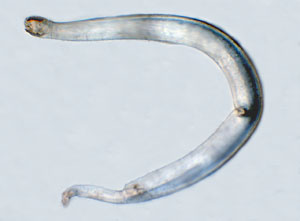Arrow Worms — Phylum Chaetognatha
Chaetognaths, also known as arrow worms, are found in the open waters of every ocean. They are very abundant and perform an important role in the marine food web as the primary predators of copepods. Three species of arrow worms, Eukrohnia hamata, Sagitta elegans, and S. maxima, have been found in the Canadian Arctic.
Arrow worms range from 0.2 to 12 cm in length and have a slender, transparent body with one or two pairs of fins. Their head is rounded and armed on each side with a group of grasping spines. Their body terminates in a horizontal tail fin, giving rise to the common name, “arrow worm.” A fold in the body wall just below the head can be drawn over the head, like a hood, for protection and to reduce water resistance when swimming.
Relying on the tufts of tiny hairs on their head to recognize the vibrations produced by their prey, arrow worms primarily feed on copepods, but will also eat amphipods, ostracods, polychaetes, planktonic tunicates, and fish larvae. Their teeth capture prey, after the hood has been folded backwards and the mouth projected forwards. The grasping spines are brought down to crush the prey, which is then stuffed into their mouth.
Chaetognaths are hermaphrodites, possessing both male and female reproductive organs in their body. Bundles of sperm are transferred from one individual to another, and fertilized eggs are subsequently released into the sea. The life expectancy of chaetognaths ranges from just six weeks in tropical waters to over two years in colder waters, such as the Arctic.

